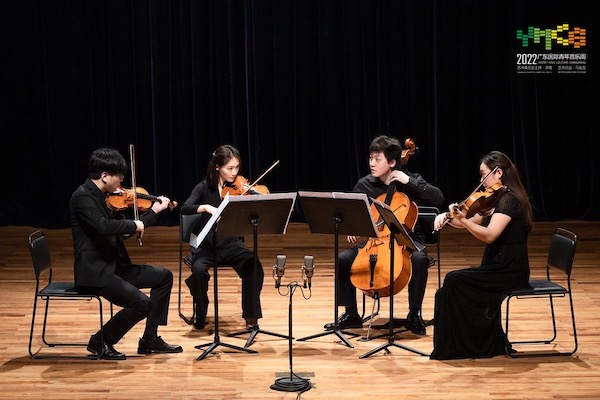One of the most exciting events at 2022’s Youth Music Culture Guangdong (YMCG) turned out to be the Discovery Beethoven Quartet concert presenting three student string quartets. The festival celebrates and cultivates young classical musicians in China, and these young musicians attended master classes via video with the renowned Shanghai Quartet. They presented a concert of their own on January 20 at Xinghai Concert Hall in Guangzhou.
A Confident Foursome
First up, the Guangzhou Symphony Orchestra Youth String Quartet performed Beethoven’s String Quartet Op. 18, No. 4 in C minor. From the composer’s set of “early” quartets, it presents a classical-style challenge to young musicians. I was immediately impressed by the GSOYSQ’s confident tempos and togetherness in the first movement, which has a bright quality despite its minor key. Aside from a few out-of-sync entrances – probably due to nervousness rather than inadequate eye contact – the musicians displayed excellent ensemble playing, with a clear understanding of the structure and dynamics and a solid feel for the movement’s brisk melodic inventiveness.
Where a slow movement normally comes, Beethoven here composed an “Andante scherzoso quasi allegretto” in C major. Scherzo-like, it elicited an appropriately light touch from the student musicians. The Minuet that follows felt slightly rushed, but the musicians were up to the tricky timing of its Trio section, and ultimately the seriousness of this “dance” number came through.
They were at their best in the Finale – perhaps nervousness had dissipated by this time – delivering a stellar upbeat reading, rhythmically precise, strong individually and firmly locked in as a group – impressive and delightful.
Shakespearean Tragedy
Next up, the China Philharmonic Orchestra Youth String Quartet performed Op. 18, No. 1 in F major, the first in Beethoven’s early set (though actually the second string quartet he composed). The young musicians established a sense of confidence immediately, loping through the first movement with coordinated agility.

It’s the startling, woeful and intense slow movement that forms the heart of this quartet. Beethoven is said to have had the tomb scene from Romeo and Juliet in mind when he wrote it. Only an occasional lapse in intonation marred a searching performance that showed the young ensemble already has the mature emotional range required.
The Scherzo has plenty of drama itself, and demands tricky scampers by the first violin. The Finale makes its own technical demands – nimble fingers absolutely necessary – but also requires the musicians to be very comfortable with the expressive contrapuntal and fugal passages Beethoven wove in as he demonstrated his mastery of the form in which he said at the time he had only just learned to compose. The CPOYSQ delivered on all fronts.
Heroic Drama
Most impressive of all was the Shanghai Symphony Orchestra Youth String Quartet, which took the stage to play Beethoven’s String Quartet No. 10 in E-flat major, Op. 74. This middle period quartet, known as the “Harp,” begins with a roiling, sinewy 10-minute sonata-form movement which the SSOYSQ played with admirable spirit and sensitivity – one might even say, with a touch of the “heroism” that labels this period of Beethoven’s oeuvre. At one moment, where a furious exchange of measures between the different instruments dissolves into almost nothing, I found myself holding my breath.

No. 10 has much more of the elaborate drama that Beethoven introduced to classical music than one finds in his youthful though masterful Op. 18 pieces. That’s certainly so in the “Adagio.” The somber sweetness of this slow, ineffable rondo emerged fully articulated in a captivating performance. The Scherzo then spun like a whirlwind, performed with the precise synchrony and rhythmic steadiness that are needed to convey its flushed passion. The cellist’s dexterity was especially impressive.
As for the Finale, some of its variations came together better than others. This movement gives the individual musicians space to showcase, but aside from that, I suspect the group didn’t find as much to love in it as they did in the other three movements, which I too have always found more thrilling.
Altogether, though, the SSOYSQ’s performance was a turbo-charged finish to a concert that showed some of China’s best up-and-coming string players in a glowing light, young musicians of which the Shanghai Quartet and the entire YMCG should have good reason to be proud.
 Blogcritics The critical lens on today's culture & entertainment
Blogcritics The critical lens on today's culture & entertainment




